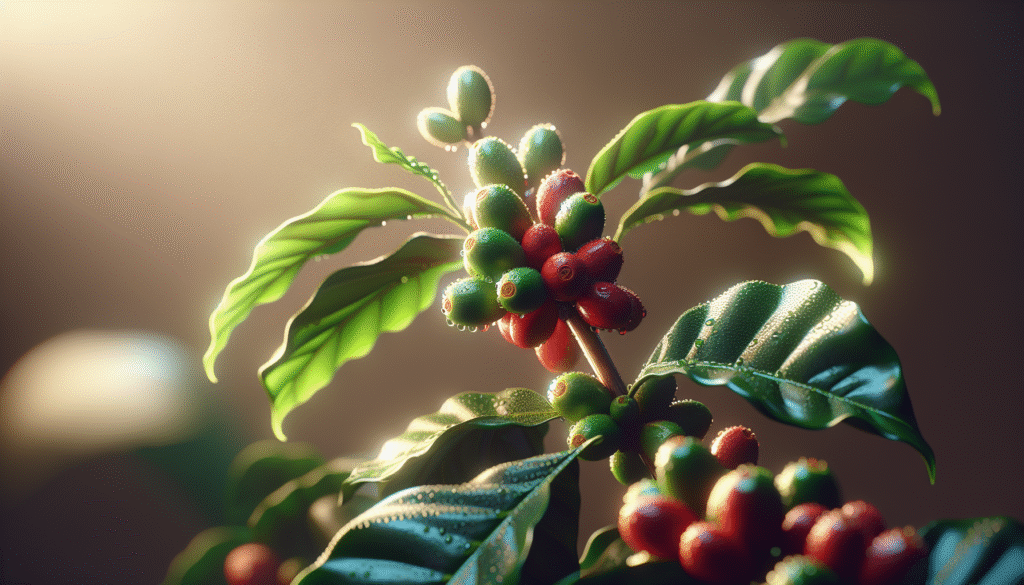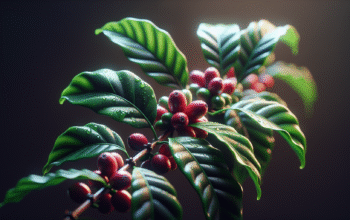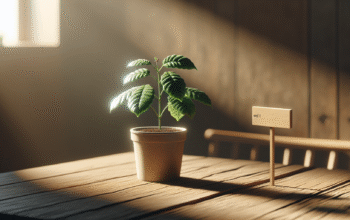Have you ever thought about growing your own coffee plant and sipping a cup made from cherries you nurtured yourself?

Practical Coffee Plant Information and Care
This guide gives you practical, step-by-step information to help you grow, maintain, and care for coffee plants. Whether you want a single potted plant for indoors or several shrubs in a garden, you’ll find clear advice on light, water, soil, pruning, pests, and harvesting.
What a coffee plant is and why you might grow one
A coffee plant (genus Coffea) produces the coffee cherries that contain the seeds roasted to make coffee. You might grow one for the ornamental glossy leaves and fragrant flowers, for a personal harvest of coffee cherries, or simply to enjoy a low-maintenance, attractive houseplant. Growing coffee can also be rewarding if you enjoy hands-on gardening and learning about how crops develop from seed to cup.
Coffee plant species and varieties
Knowing the main species and varieties helps you select the right plant for your climate and goals. The two most commonly cultivated species are Coffea arabica and Coffea canephora (robusta).
Coffea arabica
Arabica accounts for about 60–70% of global coffee production. It prefers higher altitudes, cooler temperatures, and produces sweeter, more nuanced beans. If you want better-tasting coffee and can provide the right growing conditions, arabica is the usual choice. It is more frost-sensitive and less disease-resistant than robusta.
Coffea canephora (robusta)
Robusta is hardier, more tolerant of heat, lower altitudes, and many pests and diseases. It produces higher caffeine content and stronger, more bitter flavor profiles. If you live in a warmer climate or want a low-maintenance plant, robusta may be more forgiving.
Cultivars and dwarf varieties
You can find dwarf cultivars and hybrids bred for compactness and disease resistance. Dwarf varieties are ideal for indoor containers or small gardens. When choosing a plant, read labels for cultivar traits like size, flowering frequency, and disease resistance.
Origin, habitat, and natural history
Understanding a plant’s natural habitat helps you recreate favorable growing conditions. Coffee is native to tropical Africa, particularly Ethiopia, and spread to tropical areas worldwide.
Native environment
In the wild, coffee shrubs grow under forest canopies with filtered light, high humidity, and well-draining, organic-rich soils. They experience consistent temperatures without extreme cold. Mimicking these conditions will help your plant thrive.
Lifecycle overview
A coffee plant begins as a seed or cutting, establishes roots, produces leaves and stems, flowers seasonally, and sets cherries that contain two seeds (beans) each. It can take 3–4 years before a seed-grown coffee plant yields its first harvest, though grafted or nursery-grown plants may fruit sooner.
Choosing the right location
Selecting the right site will set you up for success. Light, temperature, humidity, and protection from extremes are key.
Light requirements
Coffee plants grow best in bright, indirect light. Outdoors, they thrive under a light shade or dappled sunlight, similar to a forest understory. Indoors, place your plant near an east- or north-facing window where it receives bright, indirect light for most of the day. Direct afternoon sun can scorch leaves; if your location gets strong sun, use a sheer curtain or place the plant a few feet back from the window.
Temperature and climate
You should keep arabica between roughly 15–24°C (60–75°F), while robusta tolerates slightly higher temperatures. Avoid prolonged exposure below 10°C (50°F). Sudden temperature swings can stress the plant, so protect it from drafts, air conditioners, and heaters.
Humidity
Coffee plants prefer moderate to high humidity, often 50–80% if possible. In dry indoor environments, increase humidity with a pebble tray, frequent misting, or a humidifier. Grouping plants together also raises local humidity.
Air circulation
Gentle air movement helps prevent fungal issues and promotes sturdy growth. Avoid placing the plant in stagnant zones, but prevent direct cold drafts or strong winds.
Soil and potting mix
Soil is vital because it influences drainage, root health, and nutrient availability. Use a loose, well-draining potting mix rich in organic matter.
Soil characteristics
Aim for slightly acidic soils (pH 6.0–6.5). Good soil should retain moisture but drain freely to prevent waterlogging. A mix of potting soil, compost or leaf mold, and perlite or coarse sand works well. You can also use a peat-based mix amended with organic matter for added acidity.
Pot selection and drainage
Choose a pot with drainage holes to avoid standing water. Terra-cotta pots breathe and help prevent soggy roots but dry out faster. If you prefer plastic pots, monitor moisture more closely. For larger shrubs, use a container that gives root space; repot every 2–3 years or when the plant becomes root-bound.
Watering: How much and how often
Watering correctly is one of the most common care mistakes. Overwatering is more harmful than being a bit dry.
Watering principles
Water thoroughly until water drains from the pot’s holes, then allow the top 2–3 cm (1 inch) of soil to dry before watering again. Frequency depends on pot size, soil mix, temperature, and humidity. In homes, you may water once a week; outdoors in warm weather, more often.
Water quality
Coffee plants prefer slightly acidic, low-salt water. If your tap water is very hard, consider using filtered or rainwater. Excess salts from fertilizers can accumulate; flush soil periodically by watering abundantly and letting excess drain to reduce salt buildup.
Fertilizing and nutrient needs
Regular feeding keeps your coffee plant vigorous and productive. Use balanced, slow-release fertilizers or liquid feeds tailored to houseplants.
Macronutrients and micronutrients
Provide nitrogen for leafy growth, phosphorus for root and flower development, and potassium for overall plant health and fruiting. Micronutrients like iron and magnesium are also important, especially if you grow in containers. A balanced fertilizer with a ratio like 10-10-10 or a houseplant formula applied at half strength is a good starting point.
Feeding schedule
For continuous growth, feed monthly during the growing season (spring through early fall). Reduce feeding in winter when growth slows. If you notice pale leaves or poor growth, check pH and consider a foliar feed or micronutrient supplement.
Organic options
Compost tea, fish emulsion, or diluted seaweed extract provide organic nutrients and beneficial microbes. Slow-release organic pellets mixed into the potting soil also work well for container plants.
Pruning and shaping
You should prune to control size, promote airflow, and encourage branching and fruiting.
Basic pruning steps
Remove dead or crossing branches, thin the canopy to allow light penetration, and pinch young shoots to encourage bushier growth. For ornamental indoor plants, maintain a height that fits your space by pruning the main stem or topping the plant.
Training and shaping
You can train coffee plants as single-stem small trees or as multi-stem shrubs. For better yield in shrubs, encourage multiple branches. For a tree form, choose a central leader and remove competing stems. Prune after harvest or in early spring to minimize stress.
Flowering and fruiting
Seeing a coffee plant bloom is rewarding, and the flowers are fragrant and attractive.
Flowering behavior
Coffee plants typically flower once or more per year depending on climate and care. Flowers are small, white, and jasmine-scented, appearing in clusters along new growth. After successful pollination, these flowers develop into green cherries that ripen to red or yellow depending on variety.
Fruit development and timing
From flower to ripe cherry usually takes 6–9 months. Cherries typically contain two seeds (beans), though occasionally you’ll find single-seeded peaberries. Expect variable yields when breeding from seed; nursery plants or grafted specimens may fruit more predictably.
Harvesting and post-harvest handling
Harvest timing and processing affect coffee quality.
When to harvest
Harvest cherries when they are fully colored (usually red or yellow). You can pick by hand selectively for best quality or strip-pick for convenience. For a home grower, selective picking maximizes flavor in the small batches you’ll produce.
Basic processing steps
- Pulping: Remove cherry flesh to reveal seeds.
- Fermentation or washing: Traditional washed processing uses fermentation to remove the mucilage, followed by rinsing.
- Drying: Dry beans evenly to about 11–12% moisture on drying racks or a dehydrator.
- Hulling: Remove the dried parchment layer to reveal green coffee.
- Roasting: Roast green beans to your preferred profile and grind before brewing.
You can experiment with small batches to learn how processing affects flavor. Even at home, careful drying and roasting produce drinkable coffee.
Propagation methods
You can propagate coffee plants by seed, cuttings, or air layering. Each method has pros and cons.
Growing from seed
Seeds must be fresh and planted promptly. Scarify lightly and plant in moist, well-draining mix. Germination can take 2–3 months, and plants typically take several years to fruit. Seed-grown plants show more genetic variability but are inexpensive.
Stem cuttings
Semi-hardwood cuttings root well with a rooting hormone and a warm, humid environment. Cuttings can produce a genetically identical plant that may fruit sooner than seed-grown individuals. Use a mix of perlite and peat to root and keep humidity high.
Air layering
Air layering is useful to create a mature-feeling branch with roots before separation. Make a ring-cut, apply rooting hormone, pack with moist sphagnum, and wrap with plastic until roots form. This method can produce a fast-establishing, fruiting plant.
Repotting and root care
Repot when roots crowd the pot or growth slows. Typically repot every 2–3 years.
How to repot
Choose a pot only one size larger to avoid excess soil that stays wet too long. Remove about one-third of the old soil if it’s compacted and refresh with fresh potting mix. Water after repotting to settle the soil and reduce transplant shock.
Root pruning
If roots are pot-bound, gently tease them out and prune circling roots. Coffee tolerates moderate root pruning and often benefits from it in containers.
Common pests and diseases
Pests and diseases can affect coffee plants, especially in humid conditions or when stressed.
Typical pests and control measures
Use an integrated pest management approach: monitor, isolate new plants, and treat early.
- Aphids: Suck sap, typically on new growth. Control with insecticidal soap or neem oil.
- Spider mites: Cause stippling and fine webbing, common in dry indoor air. Increase humidity and use miticide or insecticidal soap.
- Mealybugs: White, cottony insects; remove manually and treat with alcohol swabs or systemic insecticide for heavy infestations.
- Scale insects: Flat or domed pests; scrape off and treat with horticultural oil.
Below is a table summarizing common pests, symptoms, and treatments.
| Pest | Symptoms | Treatment |
|---|---|---|
| Aphids | Distorted new growth, sticky honeydew | Spray with water, insecticidal soap, neem oil |
| Spider mites | Fine webbing, yellow speckling | Increase humidity, miticide, repeat sprays |
| Mealybugs | Cottony clusters, leaf yellowing | Wipe with alcohol, use systemic or contact insecticide |
| Scale | Bumps on stems/leaves, honeydew | Scrape off, horticultural oil, systemic insecticide |
Common diseases and management
Fungal and bacterial diseases are more likely with poor airflow and excess moisture.
- Root rot (Phytophthora): Caused by waterlogged soils. Prevent by improving drainage, repotting, and using fungicides if needed.
- Leaf rust: Orangish spots and defoliation on susceptible varieties. Remove infected material and apply fungicide; choose resistant cultivars if possible.
- Anthracnose: Dark lesions on leaves and fruit. Practice sanitation and use fungicides if necessary.
Sanitation, proper watering, and good air circulation are your best defenses against disease.
Troubleshooting common problems
When something goes wrong, observe symptoms and adjust care rather than guessing.
Yellowing leaves
Yellow leaves can indicate overwatering, nutrient deficiency, or poor drainage. Check soil moisture, adjust watering schedule, and consider a balanced fertilizer or soil test.
Leaf drop
Sudden leaf drop often results from temperature shock, low humidity, or repotting stress. Move the plant to a stable environment, increase humidity, and avoid heavy feeding until it recovers.
Slow growth and poor flowering
Insufficient light, lack of nutrients, or pot-bound roots can reduce growth and flowering. Ensure adequate bright indirect light, fertilize during the growing season, and repot if roots are crowded.
Indoor versus outdoor cultivation
Your care routine will differ based on location.
Indoor care
Indoors, focus on providing bright, indirect light, consistent humidity, and steady temperatures. You’ll control pests more easily but need to supply supplemental humidity and carefully manage watering.
Outdoor care
Outdoors, plant coffee in filtered shade, protect from frost and strong winds, and ensure good soil and drainage. Outdoor plants often grow faster and may yield more but are exposed to more pests and weather variation.
Seasonal care and year-round schedule
Adjust care with the seasons to match plant needs and natural growth cycles.
Spring and summer
Increase watering and feeding as growth resumes. This is an ideal time for pruning and repotting, if needed. Monitor for increased pest activity.
Fall and winter
Reduce watering and stop or reduce fertilization as growth slows. Keep the plant in a stable, cool (but not cold) area and maintain humidity. If you live in a temperate climate and have an outdoor coffee plant, bring it indoors before the first frost.
Maximizing fruit quality at home
If your goal is edible, enjoyable coffee, consider these tips.
- Harvest cherries selectively at full ripeness for the best flavor.
- Process cherries promptly and dry them evenly to prevent spoilage.
- Roasting profiles matter: experiment with light, medium, and dark roasts to find what you like.
- Small-batch roasting and careful cooling result in better flavor than rushed methods.
Sustainable and ethical growing tips
Be mindful of sustainable practices that benefit you and the environment.
- Use organic compost and avoid excess chemical inputs.
- Conserve water with mulches and efficient watering practices.
- Choose disease-resistant cultivars to reduce pesticide use.
- Save seeds responsibly and share cuttings rather than buying mass-produced imports when possible.
Propagation and gift-giving
Coffee plants make thoughtful living gifts and propagate well for sharing.
- Root cuttings or air-layered sections produce plants that will feel more mature to a recipient.
- Include care instructions with any gifted plants so the recipient knows light, water, and fertilizer needs.
Common mistakes and how to avoid them
Understanding frequent errors helps you care more confidently.
- Overwatering: Let the soil dry slightly between waterings and use well-draining mixes.
- Too much direct sun: Provide filtered light or shade cloth outdoors.
- Ignoring humidity: Use humidity trays or humidifiers if air is too dry.
- Using wrong soil pH: Aim for slightly acidic soil; adjust with peat or sulfur if needed.
Advanced care and experimental techniques
Once you master basic care, you can try advanced practices to enhance growth or yield.
- Shade management: Adjust shade levels outdoors to influence flowering and berry development.
- Grafting: Graft desirable cultivars onto hardy rootstocks to combine traits like disease resistance and flavor.
- Controlled environment growing: Use grow tents or greenhouses with controlled humidity, light, and temperature for predictable results.
Summary care checklist (quick reference)
A concise table to keep essential needs at a glance.
| Category | Ideal condition |
|---|---|
| Light | Bright, indirect light; morning sun OK |
| Temperature | 15–24°C (60–75°F) for arabica; slightly higher for robusta |
| Humidity | 50–80% |
| Soil pH | Slightly acidic, 6.0–6.5 |
| Watering | Thorough but infrequent; top 1–2 cm dry between waterings |
| Fertilizer | Balanced feed monthly during active growth |
| Pruning | Annually or as needed to control size and shape |
| Repotting | Every 2–3 years or when root-bound |
Frequently asked questions
How long until my coffee plant produces cherries?
From seed, expect 3–4 years before the first cherries. Nursery-grown or grafted plants can fruit sooner, sometimes in 1–2 years.
Can coffee plants survive winter indoors?
Yes. Move outdoor coffee plants indoors before frost, provide bright light, keep temperatures stable, and increase humidity to maintain health.
Is the coffee from a single potted plant drinkable?
Absolutely. Small-batch home-grown coffee can be very rewarding. While yields are small, carefully processed and roasted beans can produce a high-quality cup.
Are coffee plants toxic to pets?
Coffee plants contain caffeine and related alkaloids; ingestion can be harmful to pets. Keep plants out of reach of dogs, cats, and small animals.
Final tips to help you succeed
Growing a coffee plant is both practical and satisfying. Be patient—coffee rewards steady, attentive care. Start with a healthy nursery plant if you want faster results, or try seeds if you enjoy beginning at the very start. Keep conditions consistent, watch for pests early, and enjoy the fragrant blossoms and glossy leaves while you learn the process from seedling to cup.
With proper light, water, soil, and attention to humidity and feeding, your coffee plant can become a long-term, attractive, and potentially productive part of your home garden or indoor plant collection.



